3 December, 1999
It has been a very unpredictable and exciting 24 hours. When I last talked
to you I said I might be on a flight back to Christchurch by now. Boy, how
things changed! The southbound flights from Christchurch to McMurdo were
cancelled due to weather. (BTW, so was today's, so the earliest I will get
off the ice is Sunday.) So after scrambling to get ready to leave, I now had
lots' of time. Then, Peter Webb, head of the Cape Roberts Project, came up
to me and asked if I would like to go on a trip to the Dry Valleys. Peter
often tries to arrange these trips for the CRP team members towards the end
of the season, but recently, a New Zealand helo had a mechanical problem so
there has been no extra flying time available.
A trip to the Dry Valleys is a very special opportunity for anyone.
The McMurdo Dry Valleys are located across the Ross Sea on the continent.
They are, without a doubt, the most unique environments on the face of the
Earth. In the midst of all this ice, snow, glaciers and sea ice there are
several snow-free landscapes of barren sand and rock that are the driest
places on Earth. Liquid water has probably not fallen here for at least 2
million years. About 4 inches of water falls as snow each year, but it
mostly evaporates or is blown back out of the valleys before it can melt,
pushed by fierce "katabatic" winds that roll down from the high ice plateau
beyond the surrounding mountains. To have the opportunity to visit this rare
location is a treasure indeed. That was exactly what was being offered to
me. I could not get the words "I'm there!!!!!!" out of my mouth fast enough.
We met at the helo pad at 6:30PM with our ECW gear. We were planning
on being out all night. (Helo time for such "extra trips" is only available
at night.) Gary Wilson, a geologist from Oxford University, would be leading
the field trip. There would be 8 members of the Cape Roberts team along with
two pilots on the flight. We donned our helmets and off we went. We flew
across the Ross Sea and entered the first of the Dry Valleys, the Taylor
Valley. As we flew up the deep, glacially carved valley, we saw many valley
glaciers entering the larger valley from each side. We landed on a large
rock mountain in the middle of the valley called Nussbaum Reigel. From this
vantage-point we could see the nose of the Taylor glacier toward the top of
the valley. On the valley floor we could see Lake Hoar and Lake Fryxell,
two of the several frozen lakes found in the dry valleys. We then flew to
the head of the Taylor Valley to Aztec Mountain. At this location, we looked
for fossils in a coal bed high up the valley wall. We found some imprints of
plants. Gary indicated these may be fossils of a plant also found in Africa
and Australia and is one of the major pieces of evidence for the existence
of the super-continent of Gondwanaland. We then flew to the top of the
Taylor Valley and into the Wright Valley. At the top of the Wright Valley we
flew over a spectacular icefalls formed as the Upper Wright glacier falls
from the polar plateau down into the valley floor. We landed on a bare rock
promontory in the middle of the valley. This gave us a spectacular view of
the icefalls and Lake Vanda at the bottom of the valley.
The helo then flew down to Lake Vanda and dropped us off. The helo left to
refuel. While they were gone, we had the opportunity to explore the area
around Lake Vanda. It seems weird to see a frozen lake in the middle of all
this incredible dryness. Obviously, there is enough glacial run-off to feed
the lake. Lake Vanda even has an inlet stream, the Onyx River, from which we
could get a drink. We walked out on the thick lake ice. It was like going
ice fishing with my buddies. Except that there are no fish in Lake Vanda or
any of the lakes in the dry valleys. There is, however, a very rich and
diverse population of algae and plankton in the lakes. There are camps at
each of the lakes and scientists are intensively studying this unique
environment. We found a full sized preserved crab-eater seal near the Lake
Vanda camp. This seal is probably over 100 years old and has been
freeze-dried by the cold dry conditions of the valley. No one really knows
how the seal got hear, but the sea is over 20 miles away and there is a
large glacier standing in the way. This must have been one lost seal.
Our trusty helo then landed us at perhaps the most unexpected site
yet. There on the floor of the Victoria Valley at the base of the Victoria
Lower Glacier stood a field of perfectly formed sand dunes. This was visual
proof that Antarctica is indeed the frozen dessert. Strewn all about the
wind-blown pavement were ventifacts. Ventifacts are angular faceted and
polish stones formed by the very strong winds in the valleys.
It was then time to return to McMurdo. As we headed back over the
sea ice, the pilots detoured to the edge of the ice and the open water of
the Ross Sea. There I saw a site I thought I might never get a chance to
see. Lined up along the edge of the ice were hundreds of Emperor penguins,
waddling, sliding and flapping their wings. It was truly a great ending to a
fantastic trip. We set down at McMurdo about 3:30AM a little tired but more
then a little exhilarated. For more information about the dry valleys, see
the website of TEA Sharon Harris at:
../tea_harrisfrontpage.html.
Being in the McMurdo Dry Valleys was like being in another world. I
think it as close to being on Mars as you can get without leaving the Earth.
NASA thought so too. They used the McMurdo Dry Valleys as a model as they
prepared for the Martian landings. I feel extremely fortunate to have had
this unique experience. After all, I won't ever get to Mars. Wait a minute,
that's what I used to say about Antarctica. Perhaps there will a Teachers
Experiencing Mars (TEM) program I could apply for. Or maybe you. Who knows?
Here is the moment you have all been waiting for; the announcement of the
name of my penguin buddy who has been with me through the entire journey and
will continue to come along with me when I visit schools. There were many
great names suggested, but I ran them all past my little stuffed friend, and
there was one that he seemed to like the best. Thanks to Mrs. Kottek's 6th
grade class at Highlands School in Appleton, my penguin buddy from now on
will be known as Pengleton. Thanks to all of you who submitted suggestions.

The Commonwealth Glacier spilling into the Taylor Valley.

The Bell 210 helicopter landed on Nussbaum Riegel in the Taylor Valley.
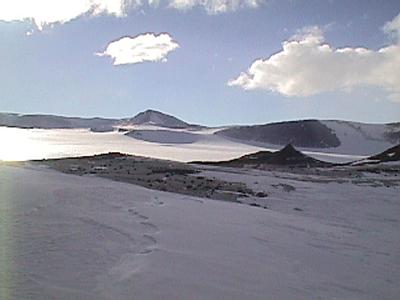
The top of the Taylor Valley. The polar plateau is beyond the head of the Taylor glacier.

The steep side of the Wright Valley.
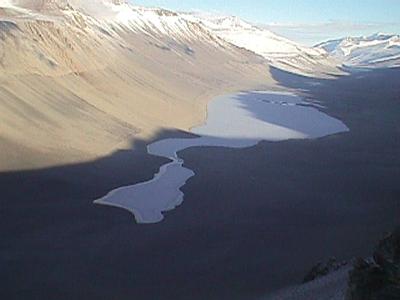
The frozen Lake Vanda lies at the floor of the Wright Valley.

Sliding on the ice of Lake Vanda. The surface was formed of smooth first year ice and rougher older ice that has remained frozen for many years.

A desiccated seal near Lake Vanda. He is lying over 20 miles from the sea. How did he get here?
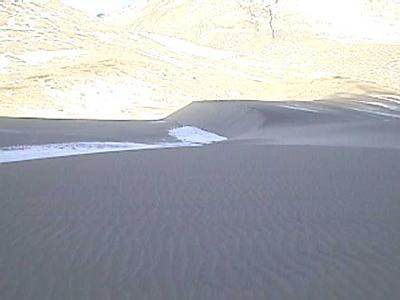
Sand dunes in Antarctica. Here they are on the floor of the Victoria Valley, one of the driest places in the world.
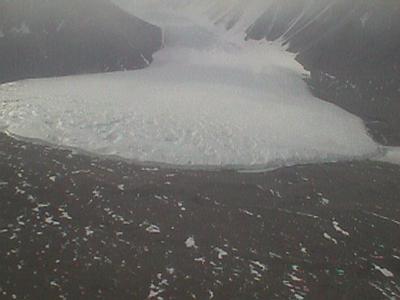
An incredible site. Looking down at the Taylor Glacier as it grinds it's way down the Taylor Valley.
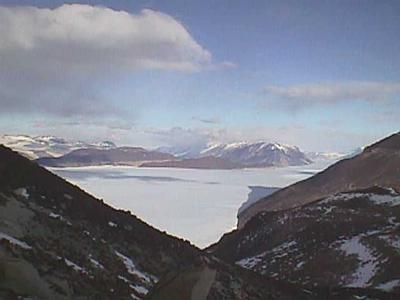
Just seeing if you were paying attention. This is really the Taylor Glacier.
Contact the TEA in the field at
.
If you cannot connect through your browser, copy the
TEA's e-mail address in the "To:" line of
your favorite e-mail package.
|
